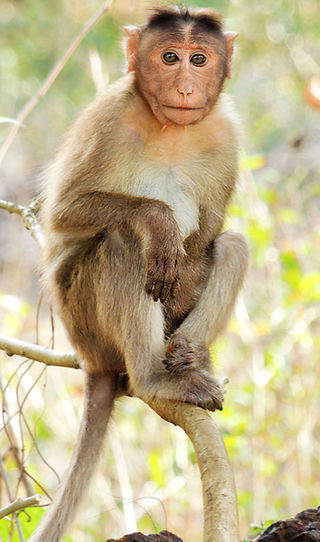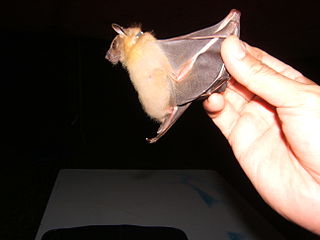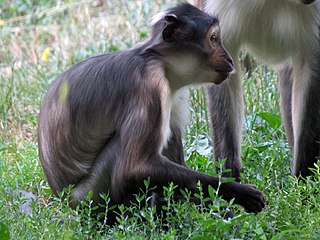
Penguins are a group of aquatic flightless birds from the family Spheniscidae of the order Sphenisciformes. They live almost exclusively in the Southern Hemisphere: only one species, the Galápagos penguin, is found north of the Equator. Highly adapted for life in the ocean water, penguins have countershaded dark and white plumage and flippers for swimming. Most penguins feed on krill, fish, squid and other forms of sea life which they catch with their bills and swallow whole while swimming. A penguin has a spiny tongue and powerful jaws to grip slippery prey.

Herring are forage fish, mostly belonging to the family of Clupeidae.

The macaques constitute a genus (Macaca) of gregarious Old World monkeys of the subfamily Cercopithecinae. The 23 species of macaques inhabit ranges throughout Asia, North Africa, and Europe. Macaques are principally frugivorous, although their diet also includes seeds, leaves, flowers, and tree bark. Some species such as the long-tailed macaque will supplement their diets with small amounts of meat from shellfish, insects, and small mammals. On average, a southern pig-tailed macaque in Malaysia eats about 70 large rats each year. All macaque social groups are arranged around dominant matriarchs.

The guenons are Old World monkeys of the genus Cercopithecus. Not all members of this genus have the word "guenon" in their common names; also, because of changes in scientific classification, some monkeys in other genera may have common names that include the word "guenon". Nonetheless, the use of the term guenon for monkeys of this genus is widely accepted.

Wobbegong is the common name given to the 12 species of carpet sharks in the family Orectolobidae. They are found in shallow temperate and tropical waters of the western Pacific Ocean and eastern Indian Ocean, chiefly around Australia and Indonesia, although one species occurs as far north as Japan. The word wobbegong is believed to come from an Australian Aboriginal language, meaning "shaggy beard", referring to the growths around the mouth of the shark of the western Pacific.

Presbytis is a genus of Old World monkeys also known as langurs, leaf monkeys, or surilis. Members of the genus live in the Thai-Malay Peninsula, on Sumatra, Borneo, Java and smaller nearby islands.

Cynopterus is a genus of megabats. The cynopterine section is represented by 11 genera, five of which occur in Malaysia, namely, Chironax, Balionycteris, Penthetor, Dyacopterus, and Cynopterus. About 30 names for Cynopterus species have been proposed, but only 16 are taxonomically valid forms.

The white-eyelid mangabeys are African Old World monkeys belonging to the genus Cercocebus. They are characterized by their bare upper eyelids, which are lighter than their facial skin colouring, and the uniformly coloured hairs of the fur. The other two genera of mangabeys, Lophocebus and Rungwecebus, were once thought to be very closely related to Cercocebus, so much so that all the species were placed in one genus, but Lophocebus and Rungwecebus species are now understood to be more closely related to the baboons in genus Papio, while the Cercocebus species are more closely related to the mandrill.
Dyacopterus is a genus of megabats from south-east Asia. It contains three species, namely:

The dayak fruit bat or dyak fruit bat is a relatively rare frugivorous megabat species found only on the Sunda Shelf of southeast Asia, specifically the Malay Peninsula south of the Isthmus of Kra, and the islands of Borneo and Sumatra. There are three species in the genus Dyacopterus: D. spadiceus, D. brooksi and D. rickarti. All are found in the forests of Malaysia, Thailand, and the Philippines. Few specimens of any of the three species exist, due not only to their rarity, but also because they rarely enter the sub-canopy of the forest where they can be caught in scientists' nets.
A near-threatened species is a species which has been categorized as "Near Threatened" (NT) by the International Union for Conservation of Nature (IUCN) as that may be vulnerable to endangerment in the near future, but it does not currently qualify for the threatened status.

An IUCN Red List Critically Endangered species is one that has been categorized by the International Union for Conservation of Nature as facing an extremely high risk of extinction in the wild. As of December 2023, of the 157,190 species currently on the IUCN Red List, 9,760 of those are listed as Critically Endangered, with 1,302 being possibly extinct and 67 possibly extinct in the wild.

The serow, is any of four species of medium-sized goat-like or antelope-like mammals in the genus Capricornis. All four species of serow were, until recently, classified under Naemorhedus, which now only contains the gorals.

Brooks's dyak fruit bat is a species of megabat in the family Pteropodidae endemic to Sumatra. It was formerly included as a subspecies of the dayak fruit bat. It is named for Cecil Joslin Brooks, who collected the type specimen near Bencoolen and presented it to Oldfield Thomas.
The subfamily Cynopterinae comprises 24 species of pteropodid bats distributed exclusively in South and Southeast Asia.













